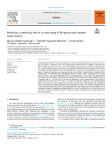Mostrar o rexistro simple do ítem
Predicting Weathering Indices in Soils Using FTIR Spectra and Random Forest Models
| dc.contributor.author | Ghebleh Goydaragh, Maryam | |
| dc.contributor.author | Taghizadeh-Mehrjardi, Ruhollah | |
| dc.contributor.author | Golchin, Ahmad | |
| dc.contributor.author | Jafarzadeh, Ali Asghar | |
| dc.contributor.author | Lado, Marcos | |
| dc.date.accessioned | 2024-01-31T16:25:58Z | |
| dc.date.issued | 2021-05-19 | |
| dc.identifier.citation | Maryam Ghebleh Goydaragh, Ruhollah Taghizadeh-Mehrjardi, Ahmad Golchin, Ali Asghar Jafarzadeh, Marcos Lado, Predicting weathering indices in soils using FTIR spectra and random forest models, CATENA, Volume 204, 2021, 105437, ISSN 0341-8162, https://doi.org/10.1016/j.catena.2021.105437. (https://www.sciencedirect.com/science/article/pii/S0341816221002952) | es_ES |
| dc.identifier.issn | 0341-8162 | |
| dc.identifier.uri | http://hdl.handle.net/2183/35292 | |
| dc.description.abstract | [Abstract] Weathering indices based on the relative proportions of different chemical elements are a useful tool to investigate the degree of weathering of soils. This characterization is missing in West Azerbaijan, northern Iran, and thus the main goals of this work were to assess the suitability of different indices to determine soil weathering, and to predict weathering indices using Fourier Transform Mid-infrared (FTIR) spectroscopy and Random Forest (RF) models. Soil major elemental oxides were determined in 12 profiles by X-ray Fluorescence (XRF), and the degree of chemical weathering was characterized using various indices: Chemical Index of Alteration (CIA), Chemical Index of Weathering (CIW), Mineralogical Index of Alteration (MIA), Weathering Index of Parker (WIP), SiO2/R2O3, Vogt Index (V) and Chemical Proxy of Alteration (CPA). For each index, a RF model based on the FTIR spectra of the samples was optimized and calibrated. The soils showed a weak to moderate degree of weathering, and CIA, CIW, MIA and V were the most appropriate for this characterization. The constructed models showed R2 values of 0.79, 0.75 and 0.71 for MIA, CIA, and CIW, respectively. The important spectral bands for prediction were those related to the presence of smectitic clays, which indicates that weathering is related to the alteration of primary minerals and the neoformation of smectites. The predicted spatial distribution of the weathering indices showed that Typic Haplocalcids and Typic Haploxerepts are at an earlier stage of weathering compared to Haplargids and Haplocambids in the area. The combination of FTIR spectroscopy and RF models is a rapid, efficient, and cost-effective technique to predict weathering indices in large datasets when XRF data are limited. | es_ES |
| dc.description.sponsorship | The authors deeply thank to University of Tabriz (Tabriz, Iran) and University of A Coruna (A Coruna, Spain) for financial assistance in performing the research | es_ES |
| dc.language.iso | eng | es_ES |
| dc.publisher | Elsevier | es_ES |
| dc.relation.uri | https://doi.org/10.1016/j.catena.2021.105437 | es_ES |
| dc.rights | © 2021 Elsevier B.V. All rights reserved. | es_ES |
| dc.subject | Aridisols | es_ES |
| dc.subject | FTIR spectroscopy | es_ES |
| dc.subject | Weathering indices | es_ES |
| dc.subject | Random forest | es_ES |
| dc.subject | Soil formation | es_ES |
| dc.subject | Spatial variability | es_ES |
| dc.title | Predicting Weathering Indices in Soils Using FTIR Spectra and Random Forest Models | es_ES |
| dc.type | info:eu-repo/semantics/article | es_ES |
| dc.rights.access | info:eu-repo/semantics/embargoedAccess | es_ES |
| dc.date.embargoEndDate | 9999-99-99 | es_ES |
| dc.date.embargoLift | 10007-06-07 | |
| UDC.journalTitle | CATENA | es_ES |
| UDC.issue | 204 (September 2021) | es_ES |
| UDC.startPage | 105437 | es_ES |
| dc.identifier.doi | 10.1016/j.catena.2021.105437 |






